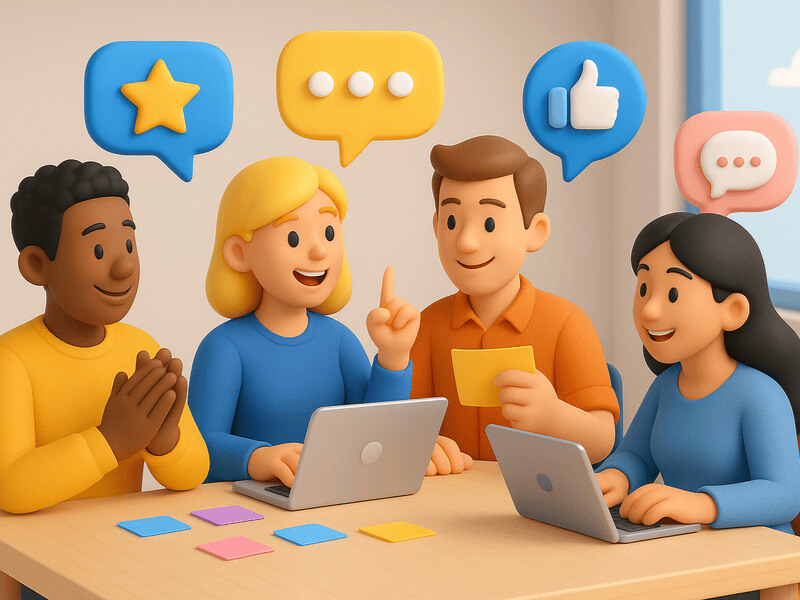
What is continuous feedback?
If you've been frustrated with the stop-and-go improvement you get from your annual performance review, continuous feedback might be the answer. Continuous feedback is an ongoing, intentional dialogue about employee performance that occurs throughout the year, instead of at one time with formal reviews. It involves giving your teams opportunities to grow year-round and can result in a dynamic feedback culture where employee development is part of everyday life.
The idea behind continuous feedback is to provide employees with regular, timely assessments of their performance and opportunities for improvement. Rather than waiting for a formal performance evaluation every six months or so, continuous feedback allows continuous interactions between employees and managers. While continuous feedback can seem overwhelming at first glance, it can also be quite flexible. Companies that implement continuous feedback programs vary the length of time between conversations to fit their needs- some have monthly check-ins while others are more frequent- and some ask supervisors to observe employees in the workplace.
Employees who are continuous feedback-ready will be open to constructive criticism and willing to learn from their mistakes. In many companies, continuous feedback is associated with continuous improvement-that is, giving employees more frequent opportunities for training and growth. The employee experience in these companies leads to high employee morale and low turnover.
Benefits of continuous feedback
One of the most significant benefits continuous feedback provides is that it makes continuous improvement an intrinsic part of team members' jobs. In companies that have a continuous feedback system in place getting better at what you do is just part of company culture. Rather than wait to be given input, many employees take the initiative to ask for feedback and make changes where changes are needed.
Successfully implementing a continuous feedback system can improve communication between managers and employees. When managers make the effort to check in regularly throughout the year, they help set clear expectations for employees' performance.
Understanding a continuous feedback loop
A continuous feedback loop is defined by continuous interaction between an employee and their supervisor or manager. Think of it as the continuous cycle of soliciting and receiving continuous feedback, which can be formal or informal depending on your company culture. A continuous feedback loop is important for continuous learning, as that employees are constantly being assessed to ensure all resources are in place to support continuous growth.
The continuous employee feedback process might begin with collecting frequent feedback data from employees, analyzing continuous feedback results to determine continuous improvement opportunities, and finally deciding on continuous improvement solutions.
- Start by generating a list of timely feedback questions to ask your employees that will allow you to gather continuous feedback data relevant to continuous improvement initiatives.
- Then, collect continuous employee feedback from your employees as they answer survey questions.
- Next, analyze continuous feedback results to determine continuous improvement opportunities and get continuous improvement initiatives moving in the right direction.
- Finally, decide on continuous improvement solutions based on continuous employee feedback analysis and implement continuous improvement initiatives that will produce positive continuous feedback results.
Managers can benefit from continuous feedback as well. The continuous feedback process can feel daunting at first, but being coached by senior leadership throughout the year can help managers to better understand their employees and how to best support them.
Continuous feedback performance management
Continuous feedback performance management is continuous feedback applied to the performance management process. It's an employee-focused performance management system in which three types of feedback: celebratory, instructive, and constructive, are given special emphasis. Continuous feedback for employee performance evaluation has become more prevalent as companies look for continuous improvement opportunities in/outside of their organizations. It encourages management to take a coaching role as they foster a growth mindset among members of teams and departments.
What this means in practice is that, as a manager, you're interacting with each of your team members regularly, providing both positive feedback and constructive feedback throughout the workday. No one likes to be micromanaged, so there might be a fine line to tread, but the key here is to see yourself more as a coach than as a boss and give your subordinates power to make decisions within their area of expertise. The ideal praise to criticism ratio is 5 to 1, so keep that in mind as well, and send out 5 kudos for every constructive feedback you send out.
Continuous feedback models
The continuous feedback model you choose will depend on your company culture and HR goals. The most widely used continuous feedback and improvement models include:
Total Quality Management (TQM) is an over-arching continuous feedback model that invites all employees into continuous improvement. Employees are self-directed, empowered, and in a continuous integration system with horizontal connections that allows them to reach their full potential. TQM is customer-focused and process-oriented and guided by strategic management and fact-based decision-making.
Six Sigma is five-phase loop-based improvement model which focuses on the steps define -> measure->analyze -> improve-> control -> define again. Characteristics of Six Sigma include an emphasis on continuous efforts to achieve stable and predictable process results, as well as a focus on management leadership and support.
Theory of Constraints is a continuous improvement model in which production or the achievement of organizational goals is viewed as being limited by a finite number of constraints. In this model, the constraints are identified, then studied to determine the best exploitation point. When the best point to attack a constraint has been decided upon, everything is subordinated to that decision, the constraint is alleviated, and then the next issue is focused on.
Using continuous feedback doesn't mean you are required to follow one of these continuous feedback models. A more informal approach to continuous feedback could include implementing the use of feedback software like the free Slack app Matter and encourage employees to ask for and send feedback.
Good continuous feedback management is based on communication, and companies have to be open with their employees about constant feedback expectations if they are going to get the desired continuous feedback results. Make performance management communication at your company simple by being upfront about continuous feedback expectations, asking your employees for continuous feedback when you see they are struggling or excelling in a task, and encouraging continuous feedback within a continuous feedback loop.
HR managers can look at continuous employee feedback as a framework to help them solve problems and discover opportunities for continuous improvement. Using continuous employee feedback, HR managers can take continuous performance management programs from good to great by:
- asking employees for their continuous feedback on what they need from managers to perform,
- identifying continuous feedback roadblocks that may be holding employees back, and
- implementing continuous feedback programs to solve the identified problems.
Continuous feedback form templates
A continuous feedback form template can make it easy for your employees to request and give continuous feedback. A continuous feedback form template gives employees clear continuous feedback guidelines and makes sure continuous employee feedback results are consistent with continuous performance management expectations. Questions will vary depending on the continuous feedback program you choose to implement, but may include:
- How can I work better with you?
- What kind of recognition do you need from me?
- How do you want to be supported in continuous performance management?
- What kinds of continuous feedback will help you be successful?
On the continuous feedback app Matter, a continuous feedback form template is an easy-to-use online form that allows you to both give and request feedback. An individual requesting feedback has the opportunity to write a short message inviting feedback, then chooses from skills they would like to be rated on.
The individual receiving feedback receives the invite and an easy-on-the-eyes evaluation form that allows them to rate skill numerically as well as leave more specific 'notes' or constructive criticism in the form of free form feedback. Both ratings and constructive criticism are made available to the feedback requester in a visually appealing feedback form template.
Final tips on continuous employee feedback
When implementing continuous employee feedback at your organization, you'll want to make sure everyone is on the same page and knows what's going on. Here are some best practices:
- Be open about continuous feedback expectations and continuous employee feedback guidelines for employees to follow when they give or receive continuous feedback.
- Identify roadblocks to continuous feedback, like fear of continuous performance management criticism or lack of confidence in skills, then implement development programs to help employees overcome these feedback obstacles.
- Include continuous feedback in continuous performance management by encouraging employees to give continuous feedback to managers and asking for peer feedback when you see an employee struggling or excelling.
- Use continuous feedback software like Matter that makes it easy for employees to constantly communicate with one another and get input from peers and managers on an everyday basis.
- Implement a continuous feedback loop by including a continuous feedback mechanism in continuous performance management plans and looking for continuous feedback opportunities when employees excel or struggle in their roles
- Organize continuous feedback results from your continuous employee feedback software so they can be used to create continuous improvement plans.
- Use a continuous feedback form template that helps employees understand how they should give and receive continuous feedback.
The key to continuous feedback is continuous communication. Employees and managers need to remember that continuous feedback loops won't work if they're not open with each other about continuous performance management expectations and continuous feedback results. if they are, though, employee engagement soars, staff morale increases, retention numbers go up, and continuous feedback can bring continuous improvement to your organization.
With continuous feedback programs, everyone wins - you get the continuous improvement results you're looking for while your employees get continuous feedback that helps them succeed.
























